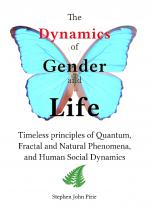[Excerpt Be and Become, © ProCreative, Sydney 2000]
Earlier, the model of existence as being the inseparable-duality of the physical (finite and known) and the “spiritual” (infinite and unknowable) was introduced.
We know that if we stay under the speed of light, our everday world of physical things remains fairly routine and reliable. Einstein’s theory of relativity provides us a predictable framework for how the everyday world of things behave, at least up to the speed of light. As we travel faster, the theory of relativity predicts that we will age slower, become heavier and smaller by well-defined amounts (relative to someone not travelling so fast). Relativity, now well-proven experimentally, also posits that as we approach and reach the speed of light, time will slow to a stand-still, we become infinitely heavy and we will shrink to a point. It would also take an infinite amount of energy to reach the speed of light.
In many respects, physical reality together with everything and everyone within it is “imprisoned” by the speed of light. Within this little enclosure or playpen we call physical existence, forces such as gravity operate at or below the speed of light. Things affect other things in certain definable ways. Any action, force or application of energy always takes time to affect the local environment. This time delay produces a buffering effect. We are buffered inside little spacetime cocoons, insulated from an immediate interaction with distant phenomena. We have time to respond to the world around us. Within our cocoons, we are insulated by a substance called “time.” Something “way way over there”, takes time to get “here” to affect us. Because the world is so bounded by such local mechanisms, we can at this point introduce a term which conveniently reminds us of this and that is that the normal physical world is “LOCAL” to us at any point in time.
The further away things become, the slower we get to know of them or affect them. Even satellite transmission takes time for the electromagnetic signal to travel around the planet. Physicists use the concept of “LOCALITY” to describe how all information, action, forces and energy is conveyed at or below the speed of light. “Locality” means there is always a time-lag between a cause and its subsequent effect. Physicists introduced the term “NONLOCAL” to describe forces, actions or information which might be conveyed faster than the speed of light. It appears quite obvious that nonlocal action is not of this world, in that we don’t normally experience action or forces which occur faster than light. So, at this point, you might conveniently relegate nonlocal phenomena to the realm of the imagination and the non-physical. You might say that while we are physically imprisoned by the speed of light, our thoughts are free to imagine anything, including nonlocal faster-than-light travel.
We can meaningfully correlate the term “local” with the known, the finite and the predictable. As for the term nonlocal, let’s include it with the unknown, the future and the imaginary, for it is not real and not of this physical (local) world. Let’s therefore include these additional ideas as an adjunct to Table 3.4. as shown in Table 3.5 below.
|
Unknowable |
'NOW' moment |
Known, Knowable |
|
(Infinite) |
Finite, Real, Measured |
|
|
Future |
Past |
|
|
Nonlocal, At-Once |
Local, |
|
|
Imaginery |
Fact, Real |
In its own way, Table 3.5 is significant for it initiates the idea that anything “local” is limited by time and space.
Anything nonlocal is, theoretically at least at this point, Unlimited (by time and space). Since a local influence or force takes time for it to transfer through space, a nonlocal influence, on the other hand, would be immediate and independent of time and space. That is to say, a nonlocal influence or connection between say two people would operate instantaneously no matter how far
apart they were. We might best encapsulate this by saying that local means isolation and separation.
Consequently, space and time can be considered local phenomena when sensed or observed via
our physical senses or through some mechanical, technological apparatus.
Anything which is “local” is bounded and limited (by the speed of light). Accordingly, within a local perspective, things (objects—people, cars, trees and galaxies) are perceived to be distinctly separate from each other. They are separated from each other by time and space.
“NONLOCAL” means “Interconnected”, at-once
(independent of time and space).
Events in space and time can be considered local phenomena when sensed or observed via our physical senses or through some mechanical, technological apparatus. Anything which is “local” is bounded and limited (by the speed of light). Accordingly, within a local perspective, things (objects—people, cars, trees and galaxies) are perceived to be distinctly separate from each other. They are separated from each other by time and space.
been habituated into feeling profoundly separate from ourselves (our own inner, intuitive awareness of potentials and connections).
 "The Dynamics of Gender and Life" ebook is now available at
"The Dynamics of Gender and Life" ebook is now available at